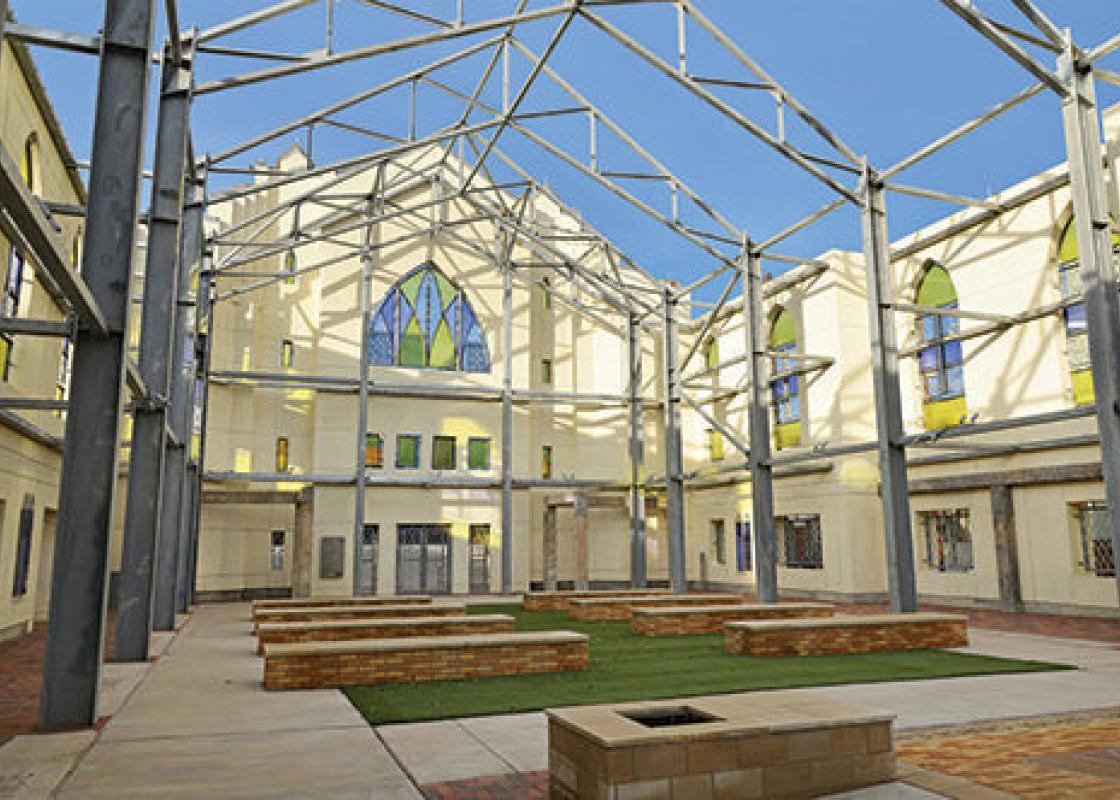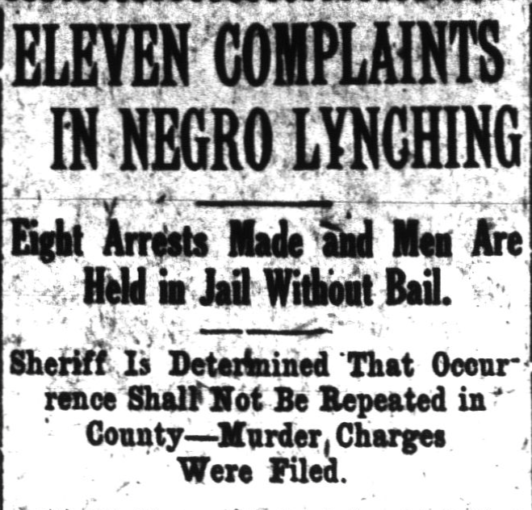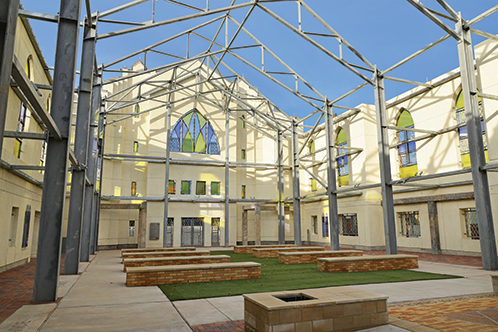Irene Vázquez is a sophomore at Yale University. She is pursuing an Ethnicity, Race, and Migration and English double major and serves as creative director of WORD: Performance Poetry at Yale as well as a staff writer for Broad Recognition, Yale's premier feminist publication.
Walking among the 800 weathered Corten steel columns at the National Memorial for Peace and Justice in Montgomery, Alabama, in early June, I could not shake the feeling that the dead were with us. Each column bears the name of a county and the names of racial terror victims who were lynched there, and as you walk through the pavilion, the columns slowly rise until they are hanging a few feet off the ground. Southern trees bear strange fruit, echoed through my head as I walked past each county, unconsciously searching for names that I recognized. Loudoun County, Orleans Parish, Plaquemine Parish … Harris County. The steel columns, which have been exposed to the elements since the memorial’s opening in April, have already weathered in a way that looks eerily like dried blood.
The Equal Justice Initiative, an Alabama-based non-profit that provides legal representation to those who may have been denied a fair trial, opened the National Memorial for Peace and Justice in April 2018. Known to many simply as the Lynching Memorial, it was unveiled in conjunction with the Legacy Museum, a masterful transformation of a former slave warehouse into a museum that documents the dehumanization and commodification of Black people that persisted through Jim Crow and into our present era of mass incarceration.
The memorial, designed by MASSDesign group and EJI director Bryan Stevenson, gracefully answers the questions posed by architect Julian Bonder: “How do we convey the critical significance of design in conceiving and creating democratic public spaces and democratic memorial spaces? How can we elaborate on the ethical implications of Hannah Arendt’s description of the public sphere as ‘the space of appearance’?” Memorials need not be flashy or explicit to be moving. In fact, they are often at their most poignant and most democratic when they choose a seemingly simple approach that can be engaged with on multiple levels by their viewer in a peaceful act of remembrance without having to relive the trauma of the past, much like the Memorial to the Murdered Jews of Europe or the Vietnam War Memorial.
On the ten-hour drive from Alabama back to Houston, I could not help but wonder why we as a country had taken so long to do something so necessary.
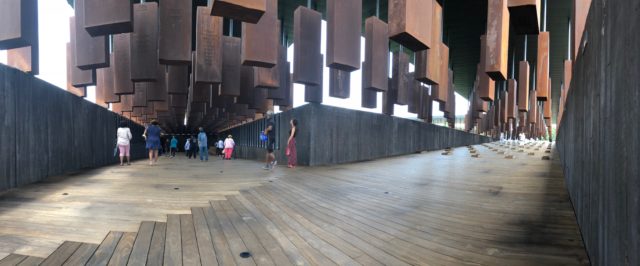 Each column at the National Memorial for Peace and Justice bears the name of a county and the names of racial terror victims who were lynched there. Photo: Jose Vazquez.
Each column at the National Memorial for Peace and Justice bears the name of a county and the names of racial terror victims who were lynched there. Photo: Jose Vazquez.
Houston is a city that is fiercely proud of its possibility. We tout our medical center, on the forefront of advances in cancer research. The Kinder Institute holds up census numbers that show us as the most diverse region in the country. We are proud of our resilience in the face of recessions and catastrophic storms. Our can-do attitude keeps us hurtling into the future, determined to be a city upon a hill. Yet this forward gaze can keep us from adequately remembering our past, which, though inspiring, is also fraught with racial violence.
The memorial in Alabama also includes duplicates of each of the steel columns, lined up along the path outside the pavilion like coffins. The Equal Justice Initiative has invited counties around the country to claim their monuments and give them permanent homes so that we might more honestly reflect our history. The monument installation is just one arm of their Community Remembrance Projects, an ongoing campaign to recognize the victims of racial terror lynchings that also includes collecting soil from lynching sites and erecting historical markers. Though the Equal Justice Initiative will not begin distributing the memorial monuments until 2019, the preliminary work to erect a historical marker here in Harris County is well on its way.
Debra Blacklock-Sloan, an African-American genealogist, historical researcher, and member of the Harris County Historical Commission, has taken the lead on local efforts to commemorate the victims of racial terror lynching. She initiated the project to place the Harris County monument on behalf of the Willie Lee Gay Chapter of the Afro-American Historical and Genealogical Society as well as the Friends of the African American Library at the Gregory School.
Blacklock-Sloan feels that lynching is an undertold story here in Houston, both for younger generations and non-Black communities.
“Houston is a great city, but there’s a lot of history that a lot of us are not familiar with,” she said. “My only goal is to get that history out.”
Blacklock-Sloan first heard about the memorial project from Bill Milligan, with whom she was working on a historical marker for Emancipation Park. Bill put her in touch with his son Evan, a Law Fellow at the Equal Justice Initiative. She has been involved with the process ever since.
After learning that Harris County Commissioner Rodney Ellis was interested in the project, Blacklock-Sloan contacted his office, and a coalition has met on multiple occasions to advance the project.
Efforts at the office of Commissioner Ellis have been spearheaded by Kathryn Kase, Senior Advisor, Strategic Development and Initiatives Department, and Sherea McKenzie, the Director of the Strategic Development and Initiatives Department.
"I look forward to working with my colleagues on Commissioners Court to bring this monument to Harris County," Commissioner Ellis said in a written statement. "It's important that we, as a community, properly acknowledge those who unjustly suffered under a system of terror and oppression. We also must acknowledge how it continues to affect present racial disparities and injustice."
Blacklock-Sloan echoed this desire, noting that she hopes that the memorial will serve as a place of reflection and ongoing dialogue: “I hope there will be some racial healing and reconciliation. It’s not just about putting the marker out there, we want people to be aware.”
These sentiments speak to the power that physical space can serve as an act of witness and acceptance of the public’s vulnerability in the healing process. The multi-step process that the Equal Justice Initiative requires for historical marker and monument installation reflects this ongoing dialogue that reconciliation necessitates. In their guidelines for the installation process, they outline a one- to three-year educational process involving a diverse coalition of historians and community members with a history of restorative justice efforts. The marker must include two sides, one commemorating the county-specific victims and the other detailing the history of racial terror lynchings as a national phenomenon rooted in myths about inferiority and superiority.
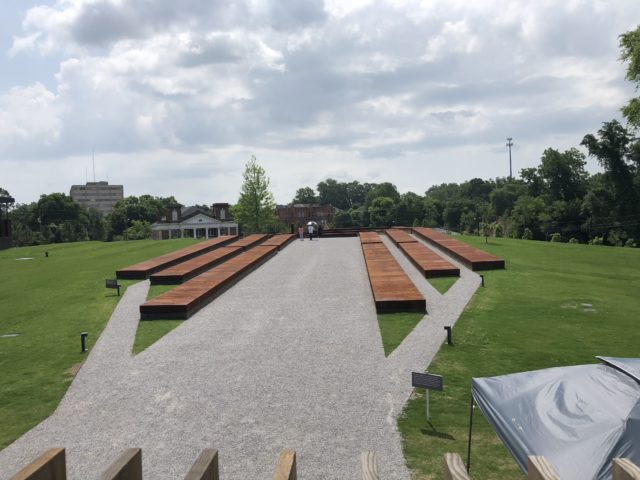 Duplicates of each of the Corten steel columns lay outside the pavilion, waiting to be claimed by the county whose victims they recognize. Photo: Jose Vazquez
Duplicates of each of the Corten steel columns lay outside the pavilion, waiting to be claimed by the county whose victims they recognize. Photo: Jose Vazquez
This commitment to education is visible in every aspect of the Equal Justice Initiative’s work. After I viewed the National Memorial and I came home to Houston, I decided to take up their call and look into the stories of the four men (the four whose murders we have documented, that is) who were victims of racial terror lynchings in Harris County: John Walton, Bert Smith, Robert Powell, and an unknown victim. For all but Powell, whose murder took place shortly before Houston hosted the 1928 Democratic Convention, information is minimal.
For the most part, the history of lynchings in Harris County is found only in the work of academics like John Raymond Ross, who wrote about the lynching of John Walton in his 1983 history dissertation at Texas Tech, or John D. Márquez, who told the story of the lynching of Bert Smith in a section of his book, Black-Brown Solidarity: Racial Politics in the New Gulf South.
What information I found largely centered on the lynching victims’ deaths and not their lives. I wanted to know their birthdays, their hometowns, their livelihoods. I wanted to know who they left behind. In the absence of that information, and in the face of a feeling that looked a lot like loneliness, I knew I owed it to them to remember as best I could.
These are the stories I could find.
I don’t know much about John Walton, aside from the fact that he was suspected of burglary and attempted rape in 1890. Before he could be arrested or even questioned, Henry Roth, the owner of the burglarized home, rounded up four neighbors and followed him. Henry Wichmann, Roth’s brother-in-law and a Houston policeman, joined the group and eventually found John hiding under a house. Wichmann crawled under the house in pursuit, and John fled into the nearby woods. There he was shot down in a shower of bullets from the four neighbors. The four lynchers were arrested but released on bail and never convicted [1].
Bert Smith worked as a cook in the oil fields of Goose Creek, an area known today as Baytown. Stories differ about how exactly Bert was implicated in his alleged crimes (a refrain common to extralegal justice). On September 21, 1921, a wife of a White oil worker alleged that a Black man entered her tent at the camp while she slept. Bert became the prime suspect. According to Garrett Herring, who was present when Bert was hung, “this colored man … evidently got some whiskey somewhere and stumbled into a tent, a tent that presumably was occupied by a man’s wife. Whether he did or not, no one ever really knew” [2].
Bert was arrested and put in jail, but the very next morning, a mob of nearly a thousand oil workers swarmed the jailhouse, broke in, and took him to hang. A journalist, Frank Allen, tried to take photos of the lynching, but these photos never emerged — some accounts say his camera was destroyed, others just say that the pictures were confiscated. After the mob killed Bert, they brutalized then burned his body [3]. By his own account, Herring stood on at the window of the town drug store and watched Bert die. “I had never seen a mob before,” he said.
During this era in Baytown, the Ku Klux Klan had a prominent presence, and was known to hold weekly parades down Texas Avenue [4]. It’s no surprise then, that after Bert’s very public death, many Blacks fled the area. This effect is precisely why these lynchings are described as acts of racial terror: one man may have died, but an entire community was plunged into fear for their lives.
Though fifteen men — fifteen men out of a thousand that comprised the mob — were arrested, none were convicted.
We do not know the name of the third documented victim of racial terror lynching in Harris County (the only place I have been able to find his death documented was on the EJI Memorial). We do not know what crime (if there even was one) he was accused of. He was murdered on October 27, 1919.
Last was Robert Powell. In the early hours of June 17, 1928, two police officers asked a group of Black men (including Robert) on a street corner downtown what they were doing out so late. The two detectives, Henry Bradshaw and A.W. Davis, hassled and roughed up the men, and a gun allegedly fell out of the clothing of one of the suspects. Robert ran.
Detective Davis chased after him, and shots were exchanged. Davis was killed by a shot to the head, and Robert was severely wounded and retreated to his mother’s home in the Fourth Ward. After an aggressive search through the neighborhood, police took Robert to Jefferson Davis Hospital.
In the early hours of June 20, the mob came for Robert Powell. Witnesses reported that seven or eight armed White men charged in and took the Black prisoner they believed had shot Detective Davis from the custody of the Harris County Sheriff Department’s watchman. The mob took him out to what we know today as the intersection of I-10 West and Loop 610 on Post Oak Road, what was then six miles from downtown Houston but still in the city limits.
Around dawn, his battered body was discovered hanging from a bridge. Some witnesses alleged that the police stood by and watched him hang [5].
For far too long, the burden of remembering has lain with the communities directly impacted by racial terror. Blacklock-Sloan leads a tour group to notable African-American historic sites multiple times a year and noted that on her most recent trip to the National Memorial for Peace and Justice, some were unable to get out of the bus, they were so moved by lynching’s violent history; for many on the trip, racial terror lynching was not a historical phenomenon but an all-too real part of their family’s history.
The legacy of racial terror lynching lives on not just with them but also with the Black men who live every day of their lives knowing all too well how it feels to be a Black body in public space, gunned down for wearing a hoodie like Trayvon Martin or carrying a cellphone like Stephon Clark, justifications not too far off from the reasons men like Bert Smith were lynched not even 100 years ago.
If to be Black in public is to be fearful, to still not be free, as Christina Sharpe says in her book In the Wake: On Blackness and Being, “in the wake of the unfinished project of emancipation,” then a monument is necessary here in Houston to publicly reckon with this reality. We can valorize the lived experience of the mourning and fear that lives in the bodies of Black folks and still recognize that this knowledge can be unbearably lonely.
Monuments and memorials relieve the individual of the burden of remembrance. Architectural historian Alberto Pérez-Gómez has written about the concept of a “memory theater,” a place capable of embodying truths that make it possible to affirm life and conceptualize a better future. Erecting a memorial to the victims of racial terror in the public domain implicates the role the public played in supporting the systems that reinforced racial terror and calls upon all who view it to reckon with that past and take up the mantle of restorative justice. The structure itself is a physical act of witness and provides a site for continued witness and commemoration to take place.
The question then becomes, what would a memory theater for the victims of racial terror look like in Houston? And where would it go? The beauty of the the National Memorial for Peace and Justice lies in its capaciousness. The open-air pavilion allows air and light into an experience that is otherwise rather dark. It breathes life into its viewers, reminding us that even though the past may have been repressive and violent, we have lived to remember those who were killed, and we will go on living. Go on striving for something better.
Many sites are in discussion. As for my two cents, I propose putting Harris County’s memorial marker at Bethel Church Park in the Fourth Ward. The historic Fourth Ward already serves as a destination for those seeking out Houston’s history, as the site of Freedmen’s Town and the Rutherford B. H. Yates Museum and would bring the marker the visibility it needs. The site is less than ten blocks from the corner of Andrews and Genesee Streets, where Robert Powell was harassed by police in the encounter that would lead to his death.
Most importantly, Bethel Church Park invites us into a consecrated space of resilience. Freed slaves founded the church in the 1890s, and after the building was devastated by a fire in 2005, the City of Houston purchased the property and transmogrified it into an indoor/outdoor park with church pew style seating and stained glass windows that depict the church’s history. The Black church has long been a place of witness and collective burden sharing. The memorial would provide site-specific thought into what it means to be destroyed, to be burned, to live again.
Further Reading / Works Cited
[1] Ross, John. “At the Bar of Judge Lynch: Lynching and Lynch Mobs in America.” PhD dissertation, Texas Tech University. 1983.
[2] Márquez, John D. Black-Brown Solidarity: Racial Politics in the New Gulf South. Austin: University of Texas Press, 2014.
[3] Swofford, Sarah and Herring, Garrett R. Oral History Interviews with Garrett R. Herring, February 1980, audio recording, {1980-02-07, 1980-02-14}; University of North Texas Libraries, The Portal to Texas History, texashistory.unt.edu; crediting Lee College.
[4] Orton, Wanda. “The Klan in Goose Creek.” Our Baytown. Last modified Dec. 11, 2017.
[5] Watson, Dwight. “In the Name of Progress and Decency: The Response of Houston’s civic leaders to the lynching of Robert Powell in 1928.” Houston History Magazine, March 2014.


